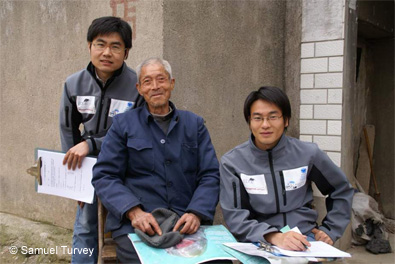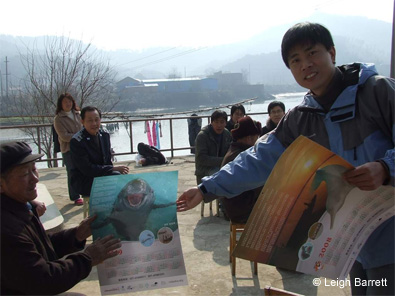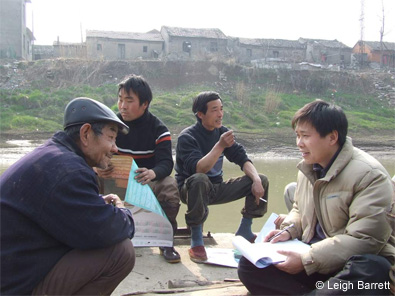Here is the second blog from EDGE’s Dr Sam Turvey about his surveys along the Yangtze River in China, trying to discover the cause behind the disappearance of the baiji, and declines other Yangtze species.
In February 2008, on the last day of the Chinese New Year festivities, we arrived in Wuhan in order to try to establish the fate of the possibly extinct Yangtze River dolphin or baiji – whether it had really disappeared for good, and what factor or factors had been responsible for its precipitous decline. Working with researchers from Wuhan’s Institute of Hydrobiology, the academic institution which had kept a captive baiji called Qi Qi alive for over 22 years, we were embarking on an intensive survey of fishing communities along the Yangtze, talking to as many fishermen as we could find about their knowledge of the river’s ecology and the status of its cetaceans and fishes.

We travelled across the entire historical range of the baiji over the next couple of months, and again when we returned to China in the autumn of 2008 following the three-month fishing ban now in place to try to help depleted fish stocks recover. Moving from town to town up and down the river, we spoke to almost 600 fishermen, using a standard questionnaire that took about half an hour to complete. As a reward for their help and time, each fisherman was given a specially printed two-year calendar, with a picture of a baiji on one side and a finless porpoise on the other, and with a hotline phone number at the bottom allowing them to get in contact with staff at the Institute of Hydrobiology if they ever saw a baiji or a stranded or dead finless porpoise in the future.
As fieldwork goes, the survey was an intensely interesting experience, both for what we learned and for the way we had to go about collecting information. Instead of searching for endangered species directly ourselves, we stayed in riverside towns, working with Chinese students to interview fishermen to learn about animals that they had last seen maybe ten or twenty years ago or more. In order to find the fishermen in the first place, and to obtain the co-operation of the local community and (more importantly) the local authorities, we had to organise banquets with the staff of the local fisheries department at every new town we visited. Every couple of days, once we had collected 30 or so interviews from the local fishing community, we would move onto another town, and the whole process would begin again. Although this could be extremely frustrating at times, by the end of the survey we had collected a wealth of new information about the state of the Yangtze ecosystem that would have been completely unavailable through any other kind of survey.
So what did we learn? We are now in the process of sorting through all of the data that we collected during the survey, but some facts became abundantly clear while we were still in China. Nearly all of the fishermen told us that the fisheries along the Yangtze were in the process of collapse. Fewer fish could be caught, in particular species such as Reeves’ shad and the remarkable Yangtze pufferfish; there were fewer professional fishing boats on the river these days; and almost nobody we spoke to thought that fishing was a good career for the next generation. But the fishermen were trapped in their way of life. They obtain no state support, and it is still sadly common for their children to have received minimal formal education. Their lives were hard, and they recognized that the river’s resources were running out, but there was nothing else for them to do. Many fishermen along the river were surprisingly outspoken about how they wanted to be bought out and set up in a new livelihood, either as farmers on land or farming fish in artificial pools. This could be a win-win situation both for the fishermen and for the environment, since the Yangtze’s dwindling fish stocks continue to be overexploited by local people desperate to feed themselves and their families, and the fishing gear that chokes the river continues to kill porpoises by accident. But there is, as yet, no real support for this strategy from the Chinese authorities.
As well as learning these sobering facts about human livelihoods in riverside fishing communities, we also began to learn more about what was happening to the Yangtze’s river dolphins and porpoises. This was brought home to us within a few days of starting the survey, when we were at Hukou, a small town at the mouth of Poyang Lake in Jiangxi Province. As we spoke to the last of the fishermen we needed to interview, he told us that there was a dead porpoise on the riverbank just outside the fishing village. We set off to investigate – how had this animal died?
TO BE CONTINUED



